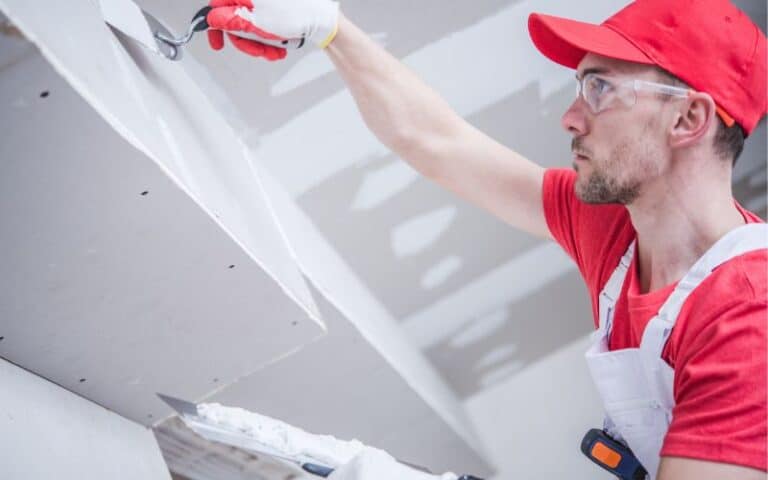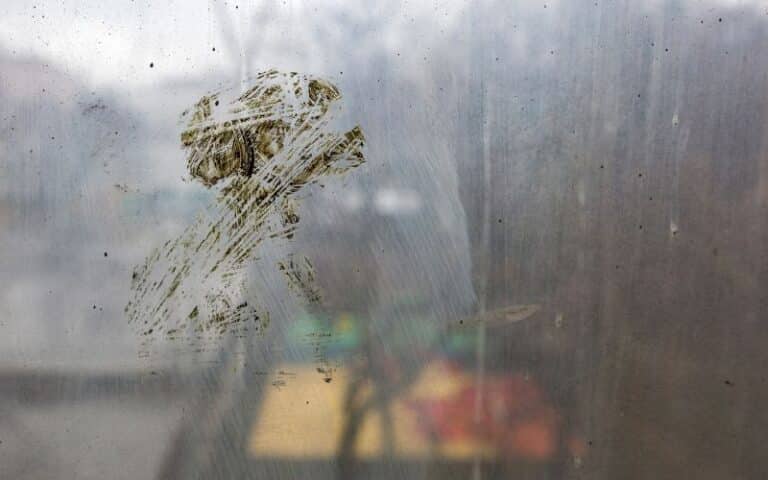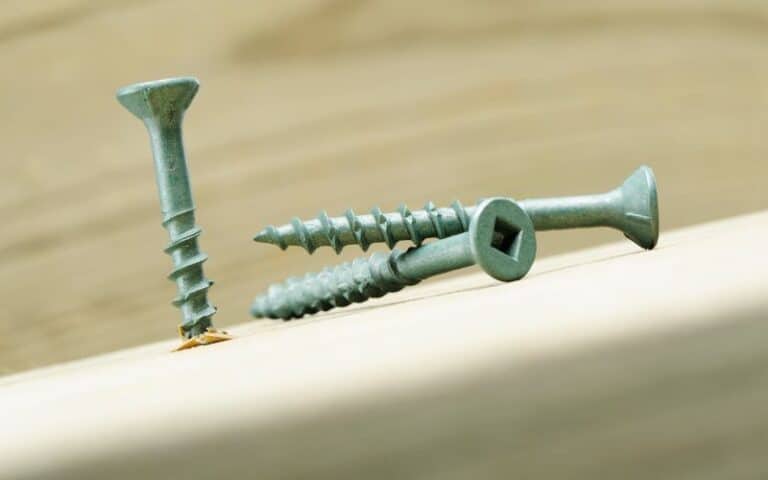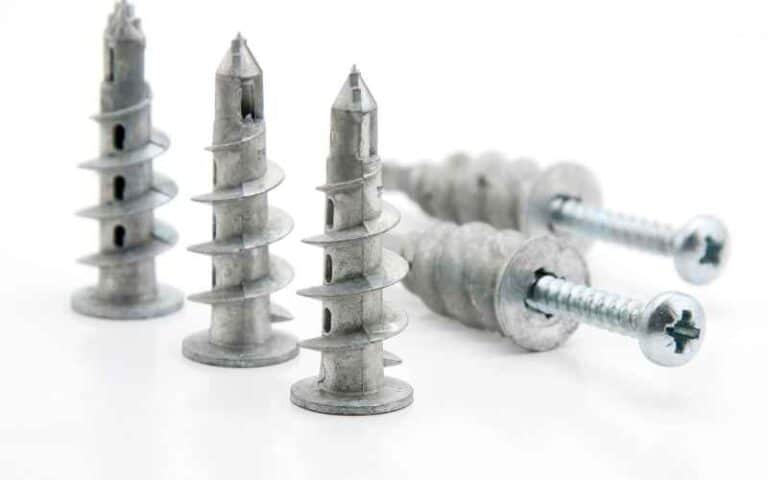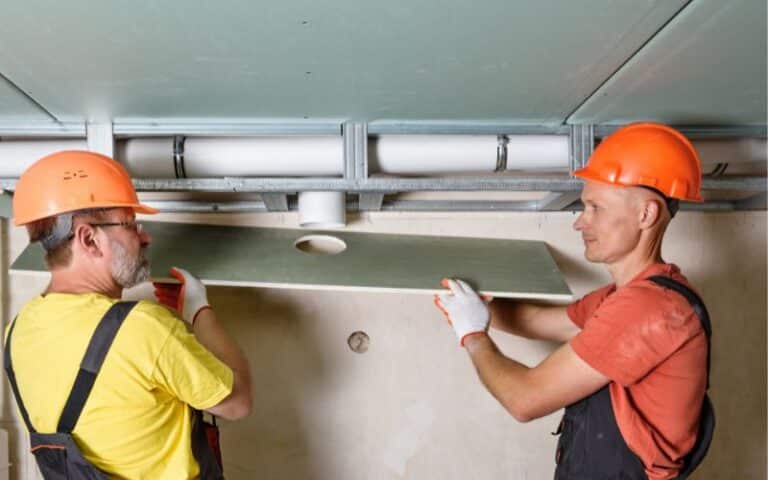The natural color of drywall joint compound mud is white. However, you can apply your drywall naturally or add color to the drywall mud before applying it.
But before you do, you have to remember that there are several colors you can use for your drywall mud, and using the wrong color or quantity can ruin your work.
You can color drywall mud for skim coats so you don’t forget where you haven’t coated yet. However, you must always use the right quantity of colored material. If you don’t use enough coloring, you won’t get the correct shade or sheen; if you use too much, it will bleed.
There are a few reasons why you need to add some color to your drywall and different materials that you can use to color your drywall.
This article contains everything you need to know to cover your drywall with the best materials.
Ready for a Drywall Quiz?
Why Do You Color Drywall Mud?

Generally, it would help if you covered drywall mud with skim coats.
The drywall is usually white, so if you apply drywall without any color in it, you can easily forget where you didn’t skim-coat.
But, if your drywall has some color, no matter how light, you can detect all the places you didn’t skim coat.
Additionally, you can add color to the drywall mud to increase the sheen of the mud. You don’t have to add color if you prefer it the way it is.
What Can I Use to Color My Drywall Mud?
If you want to color your drywall mud before applying it, there are a few materials that you can use to give you the desired color.
These include:
#1. Chalk Powder
One of the options you can explore is chalk line powder, which is a good option for you because it is very light compared to other coloring options and does not bleed when applied.
In addition, it blends well with the drywall mud, but it is very difficult to mix because it is dry powder and has no liquid issues.
Applying chalk line powder on your drywall doesn’t need any extra material. All you need to do is add some powder to the drywall mud and use your putty knife to mix it properly.
#2. Food Color
Food Color is one of the most popular methods because it is readily available, and you can mix it very easily. However, it is not the best option for you.
You have to be very careful using food coloring on your drywall mud. Although you can quickly get the desired color, it may bleed if you don’t apply your drywall mud properly.
It is quite easy to apply food color; all you need are the food color bottle, drywall mud, and the other colors that you will need to mix the two properly.
Mix your food color in one water bottle, and you must ensure the food color is consistent. Then, you mix it with the drywall mud.
#3. Tint
Tint is another great option for coloring. It would help if you had very little tint to color a lot of liquid. If you don’t want to explore other options, use tint to color your drywall.
With tint, you can get the right color without much hassle. Tint does not bleed, especially when you use the correct quantity. And it is quite easy to mix tint with drywall.
Also, you don’t need extra tools to add tint to your drywall; you only need some good tint. Then, you can mix a drill mixer and a bucket by hand if you prefer.
#4. Paint
You can also use paint for your drywall and liquid or acrylic paint to add some color to your drywall. It is easy to mix paint and blends well with drywall.
However, adding paint to your drywall mud makes it thicker and reduces the drywall’s adhesive quality.
So, always use very little paint to maintain the drywall mud’s adhesiveness and so that the mud does not thicken too much.
When coloring your drywall mud, don’t use any bright colors in case the colors bleed. It does not look good if the colors bleed through the drywall and out of the paint.
Can I Use Drywall Mud Without Coloring?
You can use drywall mud without coloring it; usually, the color of drywall is white, and some people apply white drywall with any additives.
You can also choose to apply your drywall without any coloring.
The major reason why painters color the drywall is so that they can tell the areas they’ve skim-coated apart from those that they’ve not skim-coated
If you add a little bit of color to your drywall mud, it will be easy to detect the uncoated areas of your wall.
You may miss some spots when skim-coating the wall if you don’t color your drywall.
In addition, if you don’t color your drywall, the wall will be dull even after you have finished the coating and applied the paint to the rest of the wall.
Coloring drywall gives your drywall a sheen that will not be there if you don’t color the drywall.
However, if you can skim-coat your wall without missing any spots, you don’t have to color the drywall mud.
Can You Tint Drywall Mud? What to Use
You can tint drywall mud. Adding tint to drywall mud gives the mud a sheen and also helps you to restrict the areas you’ve covered from those you haven’t when you’re working.
Adding tint to your drywall mud is a sure way to get some extra sparkle, and you can also use it to provide extreme visibility while eliminating paint flashing.
In addition, you can use it if you want to track the job and see how much progress you’ve made. That isn’t easy to do with white drywall, but you can do it with tinted drywall.
Also, when you use tinted drywall mud, you can easily find the spots you need to rework without using special lighting, so it keeps your work clean.
If you want to tint your drywall, there are some materials that you can use to achieve the best results.
Some of these materials are:
#1. Never-Miss Coloring Gel
The Never-Miss coloring gel has an excellent formula for tinting drywall compound; adding it to your drywall mud will easily guide you back to the spot you need to sand or rework.
Also, if you use it while patching, it completely hides the patch, and then you don’t have to prime the drywall after you apply the mud, although you can choose to.
You can use a 500 ml bottle of Never-Miss Coloring Gel to tint over 12 buckets of joint compound or drywall mud.
Mix the drywall mud and tint with water, a pail or bucket, and an electric drill.
#2. Chalk
You can also use chalk to add color to your drywall mud. Chalk is not just useful for coloring drywall; drywall technicians have argued that they can also use chalk to improve drywall quality.
Chalk increases the functional properties of the mud. When you add chalk, the mud sets faster and is easier to apply.
In addition, using chalk to color your drywall will give it a more textured finish, and your drywall will also have more grip so it doesn’t keep sliding when you’re working with it.
Here’s how to add chalk to your drywall:
- To add chalk to your drywall, add some drywall mud to a pail or bucket.
- Add a small quantity of chalk in your preferred color and combine it with an electric drill.
- Apply the drywall mud to your walls as usual.
- Use one tablespoon of chalk per gallon of mud to tint your drywall. However, you can use more or less depending on the nature of the mud and your preferred consistency.
Chalk also improves adhesion, serves as a binding agent, and provides better coverage for your wall, but if you’re using it to tint your drywall, do not use white chalk.
White chalk does not add color to your drywall mud, although it can serve other purposes, so add colored chalk instead.
Is it Okay to Use Food Coloring For Drywall Mud?
You can always use a bit of food coloring in your drywall mud to help you see the imperfections on your wall before sanding or painting.
Mix some food coloring with some water in a bottle and then add a small quantity to your drywall mud; then, you can use a knife or an electric drill to mix the mud with the drywall properly.
However, you should know that food coloring is oil soluble, so it may not mix properly with the drywall.
Also, food coloring is not the perfect way to tint your drywall because it will bleed through the drywall and appear on the paint, especially if it is water-based.
However, many home people use it because it is readily available and you can easily get the desired color.
If you want to use food coloring to tint your drywall mud, you should know the pros and cons of using food coloring.
The pros and cons are outlined in the table below.
| Pros | Cons |
|---|---|
| Food Coloring is easily available | It bleeds through paint, especially water-based paint |
| You can get it in any color of your choice | It does not blend well with drywall mud because it is oil-soluble. |
| It is easy to mix with drywall mud | It does not improve the quality of the drywall mud. |

